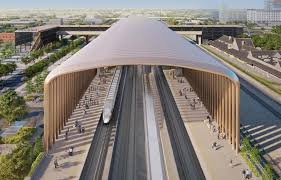
California’s high-speed rail project — long criticized as a “train to nowhere” — may have found an unlikely savior: the artificial intelligence industry. With the loss of $4 billion in federal funding under the Trump Administration, the project’s new CEO, Ian Choudri, is betting on creative revenue streams, including leasing land for AI data centers powered by renewable energy, to close the funding gap.

“We’re getting contacted by Silicon Valley investors now asking, ‘Hey, can we move data centers into Fresno and plug into your power grid that’s renewable?’” Choudri said.
The $128 billion project, which aims to connect San Francisco and Los Angeles via a 494-mile bullet train, has been plagued by delays, cost overruns, and political battles. But Choudri — a veteran of global infrastructure giants like Bechtel and Alstom — believes the solution lies in monetizing underused rail assets.
Choudri’s vision includes:
“If I combine all those ancillary revenue sources, roughly it’s going to be 30% to 40% of the farebox revenue,” Choudri told Forbes. “We’ll show that it becomes less cumbersome on taxpayers because it’s generating revenue.”
A revised plan submitted this week outlines completing the first 119-mile Central Valley segment by 2033, with extensions to San Francisco and San Jose in the north and Palmdale in the south by 2039. Los Angeles would follow later.
“Build the initial sections where you can. Start using the service. Have the highest impact on the economic transformation of the towns and cities that are getting connected,” Choudri said. “Then add more value by monetizing all the assets you have along the corridor.”

State Senator Scott Wiener supports the fresh approach: “People are looking for new approaches, creative approaches, to deliver the project more efficiently and more quickly.”
Fresno Mayor Jerry Dyer calls the project a “game-changer” for his region, which has been historically left out of major transportation corridors. “It will allow people who work in Silicon Valley to be able to commute and live in Fresno. That’s exciting for us because it would change our local economy.”
The success of this strategy hinges on a proposed $20 billion long-term funding plan from Governor Gavin Newsom, fueled by California’s Cap-and-Trade program. If approved, it could unlock new private investment from firms like Bechtel and Plenary, which have hesitated without guaranteed state backing.
Sia Kusha of Plenary notes: “The likelihood that the state will approve a 20-year financing plan is probably the biggest impetus behind why there’s new excitement in the private development community.”
Despite political criticism — including Transportation Secretary Sean Duffy’s dismissal of the project as a “colossal boondoggle” — progress is visible. More than 2,300 parcels of land have been acquired, environmental reviews are largely complete, and over 15,000 workers are active on Central Valley construction sites.
Choudri remains focused: “I need to go in and just say, ‘Alright, let’s go fix this thing because we cannot fail.’”
Originally reported by Alan Ohnsman in Forbes.